From the Field: Bill Buck in Cape Horn 2013, Day 17
Posted in Bill Buck, From the Field, Science on March 13 2013, by William R. Buck
January 26, 2013, Prov. Antártica Chilena, Comuna Cabo de Hornos, Isla Lennox, Caleta Lennox, 55°18’S, 66°51’W
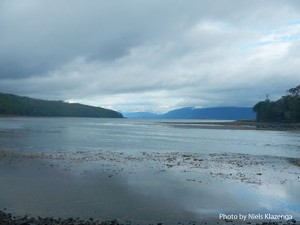 At 3:30 a.m. I hear the engine shut down, so I venture out onto the deck to see if we have arrived at our destination after taking the long way around. And in fact, we have arrived at Isla Pictón, the northernmost island of the grouping of Pictón, Lennox, and Nueva islands, and the last of our targeted areas for this year. Each of these islands still houses a naval outpost, left from a time in the 1970s when Chile anticipated Argentina would invade them. To this day, Juan feels pride in the fact that Chile defended these three islands and still holds them. On the downside, Chile also land-mined parts of the islands as part of their defense. This accounts at least in part for all the security and the hassles to get permission to visit them.
At 3:30 a.m. I hear the engine shut down, so I venture out onto the deck to see if we have arrived at our destination after taking the long way around. And in fact, we have arrived at Isla Pictón, the northernmost island of the grouping of Pictón, Lennox, and Nueva islands, and the last of our targeted areas for this year. Each of these islands still houses a naval outpost, left from a time in the 1970s when Chile anticipated Argentina would invade them. To this day, Juan feels pride in the fact that Chile defended these three islands and still holds them. On the downside, Chile also land-mined parts of the islands as part of their defense. This accounts at least in part for all the security and the hassles to get permission to visit them.
I am the first one suited up and ready to go this morning, and since the Zodiacs are in the water and ready, the crew take me ashore to a forest I point out to them. I ask to be picked up in two hours. The area is considerably more disturbed than most of our sites have been. There is evidence of inhabitants other than the navy, including the remnants of an old shack–presumably occupied seasonally by fishermen–and piles of crab traps. The forest must have seen some violent weather in the not-too-distant-past as there are numerous blown-down trees with upturned bases which make for slow going. But since I prefer to move slowly anyway, I don’t mind.
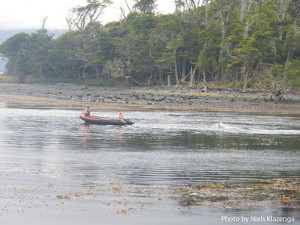 When I come out to the beach for my extraction, I find Ernesto in the Zodiac where he tells me of a nearby beach with an extensive ground cover of mosses. I ask if anyone else had collected there and since no one has, I agree to move to a second site. Now is when I must admit that I have yet to look at a map and that I do not really understand the geography of this island, and thus I have no idea that we are actually headed to a small, nearby island, Isla Gardiner. As promised there is indeed a broad swath of beach carpeted in mosses stabilizing the sandy soil. Although most are weedy, widespread species, I gather them up since, to my knowledge, there have been no previous bryophyte collections from Isla Pictón (please remember that I am still unaware that I am on another island).
When I come out to the beach for my extraction, I find Ernesto in the Zodiac where he tells me of a nearby beach with an extensive ground cover of mosses. I ask if anyone else had collected there and since no one has, I agree to move to a second site. Now is when I must admit that I have yet to look at a map and that I do not really understand the geography of this island, and thus I have no idea that we are actually headed to a small, nearby island, Isla Gardiner. As promised there is indeed a broad swath of beach carpeted in mosses stabilizing the sandy soil. Although most are weedy, widespread species, I gather them up since, to my knowledge, there have been no previous bryophyte collections from Isla Pictón (please remember that I am still unaware that I am on another island).
Ernesto next brings me to a moss that immediately catches my attention. It appears to be a small Pottiaceae on soil with all its leaf tips capped with masses of gemmae. I know I have never seen this moss before and make a large collection of it since it is a common component on the soil. Once back on the ship I show it to Juan and Blanka and both agree that they have never seen it before. In case it is a new species, Juan suggests Ernestoa pictonensis as a name. As much as I would love it to be new, I have to think that something with so many asexual dispersal agents must be fairly widespread and so may be known from nearby Argentina or the Falkland Islands. I am already anxious to get it in the mail to the Murica group that is working on this family for us.
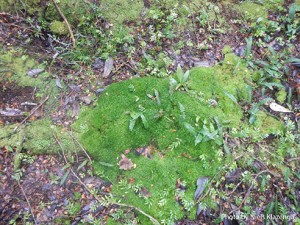 As we eat lunch, the captain moves the boat to Isla Nueva. As we eat I learn more about our agreement with the navy. Apparently we are specifically forbidden to go ashore at Isla Nueva–why I do not understand. But, seemingly this is a case of the right hand not knowing what the left hand is doing, because when we arrive in Caleta Carlos, right in front of the naval station, our captain contacts them by radio. They ask if we have permission to be there, and the captain assures them we do, and that seems to be good enough for the navy. However, this is a fairly unprotected harbor, and the captain tells us that if any wind comes up we should return to the beach immediately before the waves get too big to put the Zodiacs in the water.
As we eat lunch, the captain moves the boat to Isla Nueva. As we eat I learn more about our agreement with the navy. Apparently we are specifically forbidden to go ashore at Isla Nueva–why I do not understand. But, seemingly this is a case of the right hand not knowing what the left hand is doing, because when we arrive in Caleta Carlos, right in front of the naval station, our captain contacts them by radio. They ask if we have permission to be there, and the captain assures them we do, and that seems to be good enough for the navy. However, this is a fairly unprotected harbor, and the captain tells us that if any wind comes up we should return to the beach immediately before the waves get too big to put the Zodiacs in the water.
In any case, we only have two hours here as it is. Niels and I are the first in the Zodiac and we are dropped off on a small beach. In short order we realize we are essentially trapped on this stretch of sandy beach, only about 100 yards long, by inescapable steep sides dominated by a dense thicket of Hebe. As a consequence Niels and I finish up quickly and then wait for the Zodiac. However, I understand that Blanka has also found the mystery moss and taken photographs of it. It is still amazing to me how technologically advanced we are in such a remote area with no communication to the outside world.
When the captain sees what appears to be an approaching storm, he blows the ship’s horn and in short order we are all back on the ship heading to Isla Lennox for the night.
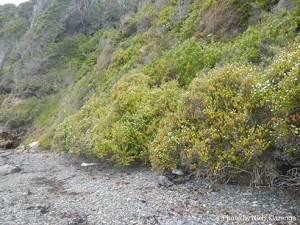 Today is Australia Day, the day celebrating the arrival of the first British colonists after Captain Cook ”discovered” Australia in Botany Bay 18 years prior. It seems that this holiday is celebrated in Australia much as we celebrate Independence Day in the United States. All day Paddy has been talking about how we must celebrate the evening by singing “Waltzing Matilda.” Unfortunately it is clear that no one knows any of the words outside of the chorus. And then, by pure chance, while listening to my iPod that afternoon during our transit, I realize I have an album by the Australian John Schuman, and sure enough, it actually has “Waltzing Matilda” on it! Additionally, Blanka has brought along a wire that we can use to connect the iPod to the ship’s speaker system.
Today is Australia Day, the day celebrating the arrival of the first British colonists after Captain Cook ”discovered” Australia in Botany Bay 18 years prior. It seems that this holiday is celebrated in Australia much as we celebrate Independence Day in the United States. All day Paddy has been talking about how we must celebrate the evening by singing “Waltzing Matilda.” Unfortunately it is clear that no one knows any of the words outside of the chorus. And then, by pure chance, while listening to my iPod that afternoon during our transit, I realize I have an album by the Australian John Schuman, and sure enough, it actually has “Waltzing Matilda” on it! Additionally, Blanka has brought along a wire that we can use to connect the iPod to the ship’s speaker system.
So, after dinner, while the crew is eating, we all gather on the bridge to listen to and sing along with the chorus to “Waltzing Matilda.” As Laura says later, it was a great show of camaraderie, especially so late in the trip when people are normally at each others’ throats. With some exceptions (which have actually turned out to be a source of entertainment in their own right) I am pleased by how well everyone is getting along and enjoying the long hours and hard work.
We have only two more days of fieldwork after which we will return to Puerto Williams for a night to retrieve the collections we left there to dry. Then, we will make a short stop to pick up fresh samples of peatmoss to be used for an intensive molecular study. It is infrequent that a researcher can request fresh material from a remote corner of the world and have a colleague fulfill that request. It’s nice to be able to do this.
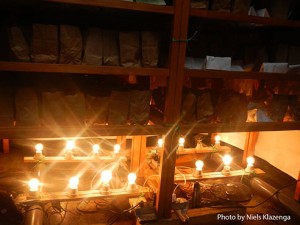
Prior to this trip I had thought that since I have previously collected at so many of these sites that I would make fewer collections this year. In the first year of this study I made about 900 collections; last year it was about 1,000 collections. This year I collected fewer mosses than in previous years so as not to duplicate collections from the same localities visited in the past. Instead I increased my collections of lichens and lichenicolous and bryophilous fungi. In the end it looks like I will end up with about 1,100 collections this year. I find it hard to resist picking up some small crustose lichen or lichenicolous fungus because it is completely possible that no one has ever collected these organisms at these sites previously, and it may be a very long time before anyone does so again. As a result I suspect that this year’s haul will ultimately have a higher percentage of type specimens than usual. And after all, isn’t that why we are here in the first place?
And finally, a confession. I am actually writing this blog at 6 a.m. on January 27. I just could not get to it yesterday. I have not been getting adequate sleep on this trip and have been quite tired the last two days. I was able to sneak in an afternoon nap two days ago as we were moving to Isla Hoste, and then again yesterday as we moved from Isla Pictón to Isla Nueva and then fell asleep quite early. And then, at 2 a.m. this morning I was wide awake. A few hours later I decided there was no competition for the shower and decided to get up for the day. I was rewarded by an almost cloudless sky and bright full moon reflecting on the calm sea when I came onto the deck. The moment was fleeting though, and gone by the time I emerged from my hot shower. The sky had once again clouded over.
Ed. note: NYBG scientist and Mary Flagler Cary Curator of Botany, Bill Buck has just returned from his annual expedition to the islands off Cape Horn, the southernmost point in South America, to study mosses and lichens. For the past two years he was able to file stories from the field, but this year’s locations proved so remote he was forced to wait until his return. We will be publishing them over the course of several days. Follow his journeys on Plant Talk.
Bill Buck’s Previous Reports From the Field:
2013
January 10, 2013, Punta Arenas, Chile
2012
February 5, 2012; Isla Londonderry, Puerto Fortuna, approximately 54º54’S, 70º26’W
February 4, 2012; Isla O’Brien, Caleta Americana, approximately 54º53’S, 70º23’W
February 3, 2012; Isla Grande de Tierra del Fuego, Fiordo Garibaldi, approximately 54º58’S, 69º49’W
February 2, 2012; Isla Gordon, middle arm of Bahía Tres Brazos, approximately 54º58’S, 69º41’W
January 31, 2012; Isla Gordon, Bahía Romanche, 54º57’S, 69º30’W
January 30, 2012; Isla Gordon, Bahía Romanche, 54º57’S, 69º30’W
January 25, 2012; Isla Darwin, Caleta Virginia, approximately 54º57’S, 70º10’W
January 23, 2012; Arm of Estero Webb, SW coast of Isla Hoste, approximately 55º14’S, 69º41’W
January 22, 2012.; Unnamed sound on Isla Gordon behind Cabo El Gorro, approximately 55º02’S, 69º48’W
January 21, 2012; Isla Hoste, Estero Fouque, 55º1’S, 69º35’W
January 20, 2012; Isla Hoste, Estero Fouque, approximately 55º11’S, 69º35’W
January 18, 2012; Canal O’Brien, just south of Isla O’Brien, 54º55’S, 70º35’W
January 17, 2012; Punta Arenas, Chile
2011
July 15, 2011; Hobart, Tasmania, Australia
July 14, 2011; Pyengana, Tasmania, Australia
July 13, 2011; Weldborough, Tasmania, Australia
July 12, 2011; Hobart, Tasmania, Australia
July 11, 2011; Hobart, Tasmania, Australia
February 8, 2011; Punta Arenas, Chile
February 5, 2011, unnamed sound northwest of Isla Georgiana
February 4, 2011, unnamed sound directly east of Seno Mama, Chile
February 2, 2011, Seno Courtenay, northern arm, Chile
February 1, 2011, Seno Courtenay, Chile
January 31, 2011, Canal between Isla Georgiana and Isla Clementina,, Chile
January 30, 2011, Unnamed sound on south side of Brecknock Peninsula, NW of Isla Georgiana, Chile
January 29, 2011, Isla Aguirre, Seno Quo Vadis, Chile
January 26, 2011, Punta Arenas, Chile
January 24, 2011, Seno Chasco, just north of isthmus to Brecknock Peninsula, Chile
January 23, 2011, Isla Grande de la Tierra del Fuego, Puerto Consuelo, Seno Chasco, Chile
January 22, 2011, Isla Grande de la Tierra del Fuego, Seno Brujo, Chile
January 21, 2011, Isla Grande de la Tierra del Fuego, Seno Brujo, Chile
January 20, 2011, Isla Grande de la Tierra del Fuego, Seno Bluff, Chile

